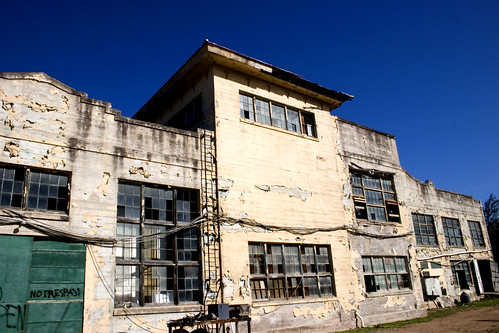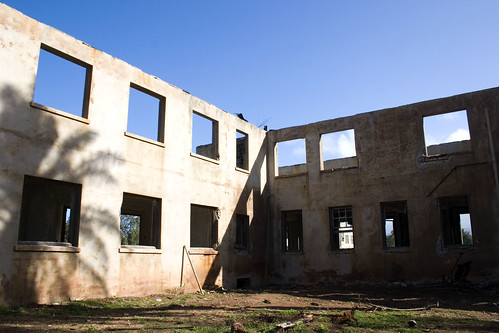Marconi, America, and the Monroe Doctrine
September 18th, 2007By Jonathan H

This is the Marconi station today (compare with historic unveiling image below). The first engineer hailed from my alma mater. Go Bears!
Editor’s Note: This is part 2 of a three-part entry on wireless radio telegraphy during World War I. In part 1, we saw the British dominance in wireless prior to World War I and the early ties between government and business. This week, we’ll follow the outbreak of the war, how it affected the Marconi wireless telegraph stations, and how General Electric cemented a permanent place as a corporation cozy with the the Defense industry.
While the shot was heard ’round the world, the British Marconi Company was touring the German radio station at Nauen. Right up until the very declaration of war, British Marconi and German-owend Telefunken were on friendly terms, but the “halcyon days,” as W.J. Baker calls them came to an end (Baker W.J., 158).
At the time, Germany‘s Nauen was the largest station in the world, carrying signals as far away as the South Pacific. For Germany, a country that depended on telegraph cables in the English Channel (susceptible to British sabotage) — nothing was more important than wireless communication. On July 29, moments after the British Marconi scientists left Nauen, the German military took over the gigantic 300,000 watt, 750-foot transmitter (Coe 214-215). Only days later, the British followed suit, ending all wireless messages and sequestering stations across the British Empire (Baker W.J., 158). Then, came the moment that allowed wireless to shine. The Brits cut Germany’s only land-line connection to the outside world. Without Nauen’s wireless towers, Germany would have lacked communication.

Nauen’s radio tower served as a vital hub for communication. Without the behemoth towers of Nauen, German would have had to depend on telegraph cables, which were often sabotaged by allied forces.
What World War I allowed the U.S. to do (whether intentional or not) was to build up a telecom infrastructure that would surpass even Britain’s. Despite the fact that it was corporate-owned, it was still government-influenced. As far back as the earliest days of the war, the spectre of military representatives were regularly described as presiding over groundbreaking ceremonies for major wireless stations. Hawaii’s Kahuku station was fast-tracked to be completed just months after the war broke out in Europe. Honolulu’s Pacific Commercial Advertiser quotes an official from Kahuku’s transpacific wireless unveiling on September 25, 1914:
“We celebrate today opening Marconi radio plant of O’ahu. The radius of action is upwards of 5,000 miles, and insures communication in time of war, regardless of any cutting of the cable.”
The quote was from Major-General Carter who, along with Rear Admiral Moore, Brigadier General Edwards, and “other prominent members of the Navy” were present at the unveiling.

The Honolulu Advertiser (then known as the Pacific Commercial Advertiser) reported on the fast-track inauguration of the Kahuku Wireless station. Kahuku was originally planned to be completed much later, but a war in Europe meant government interventionism.
Despite Wilson’s non-interventionism, the U.S. took a strong stance on building up its military infrastructure. United States’ apparent neutrality in the war was challenged when Germany’s station in Sayville New York was taken over by the government in 1914. Tensions were growing. War-hawks were squawking. On the other hand, Daniel R. Headrick in The Invisible Weapon says that “nationalistic officers of the U.S. Navy perceived American Marconi as a foreign firm, and an agent of British imperialism, and thus an enemy” (126).
The Navy, along with General Electric, was on a corporate war path to take out British Marconi. They signed contracts with American corporations to illegally produce patented Marconi apparatus. When Marconi took the case to the court in the case of Marconi Wireless v. Somin it was summarily decided that the U.S. government acted lawfully and only owed Marconi “just compensation” on the basis of “an exercise of the power of eminent domain” (“Patents”, 339). Soon, the U.S. had joined the war in 1917 — and like Germany and Britain in 1914, the military had come in to administer all wireless communications.
Please see part three to find out what happened to wireless telegraphy after the Great War, and to see how the Military-Industrial Complex also found its niche in the dominance of the country’s greatest media corporations.


 Dylan’s verse from “When the Ship Comes In” personifies the climate of 1914. The world’s seas were chained together by a vast network of underwater cables. The cables connected colonial satellites like never before. Telegraphy had been a boon to Britain. In concert with land-grab, colonial powers were grabbing communication rights, even if it wasn’t on their own shores. Dylan’s fourth verse, though, speaks for a more covert hostile takeover and the first of its kind: Imperialism in the airwaves.
Dylan’s verse from “When the Ship Comes In” personifies the climate of 1914. The world’s seas were chained together by a vast network of underwater cables. The cables connected colonial satellites like never before. Telegraphy had been a boon to Britain. In concert with land-grab, colonial powers were grabbing communication rights, even if it wasn’t on their own shores. Dylan’s fourth verse, though, speaks for a more covert hostile takeover and the first of its kind: Imperialism in the airwaves.

 Show on map
Show on map



